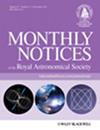猎户座复合体的运动学研究:从大小结构分析年轻恒星簇群
IF 4.8
3区 物理与天体物理
Q1 ASTRONOMY & ASTROPHYSICS
引用次数: 0
摘要
在这项工作中,我们分析了猎户座恒星形成群中具有空间和运动一致性的年轻恒星簇。在这项研究中,我们利用视差、适当运动和在色-星图上的位置选择了一个前主序候选样本。在盖亚DR3提供的5D参数空间中应用分层聚类算法后,我们将回收的星团分为两个系统:大结构和小结构,以每个星团检测到的恒星数量来定义。在第一个系统中,我们发现了 13 个恒星群,它们沿着偏角轴分布在恒星密度较高的区域。在第二个系统中,我们发现了 34 个星团,分为两种类型:其中 14 个是完全独立于大型结构的小型星团,包括 4 个候选新星团;12 个被归类为嵌入 5 个大型星团中的子结构。此外,我们还加入了来自 APOGEE-2 和 GALAH DR3 的径向速度数据,以研究猎户座星团某些区域的相空间。在大结构体系中,我们发现了猎户座 OB1 星团在一个共同中心上普遍膨胀的证据,为该区域正在经历的动力学效应提供了线索。同样,在小结构体系中,投影运动学显示了猎户座λ星团的弹道扩张,并在猎户座OB1星团中发现了星团近距离相遇的可能事件。本文章由计算机程序翻译,如有差异,请以英文原文为准。
Kinematic study of the orion complex: Analysing the young stellar clusters from big and small structures
In this work, we analysed young stellar clusters with spatial and kinematic coherence in the Orion star-forming complex. For this study, we selected a sample of pre-main sequence candidates using parallaxes, proper motions and positions on the colour-magnitude diagram. After applying a hierarchical clustering algorithm in the 5D parameter space provided by Gaia DR3, we divided the recovered clusters into two regimes: Big Structures and Small Structures, defined by the number of detected stars per cluster. In the first regime, we found 13 stellar groups distributed along the declination axis in the regions where there is a high density of stars. In the second regime, we recovered 34 clusters classified into two types: 14 as small groups completely independent from the larger structures, including four candidates of new clusters, and 12 classified as sub-structures embedded within five larger clusters. Additionally, radial velocity data from APOGEE-2 and GALAH DR3 was included to study the phase space in some regions of the Orion complex. From the Big Structure regime, we found evidence of a general expansion in the Orion OB1 association over a common centre, giving a clue about the dynamical effects the region is undergoing. Likewise, in the Small Structure regime, the projected kinematics shows the ballistic expansion in the λ Orionis association and the detection of likely events of clusters’ close encounters in the OB1 association.
求助全文
通过发布文献求助,成功后即可免费获取论文全文。
去求助
来源期刊

Monthly Notices of the Royal Astronomical Society
ASTRONOMY & ASTROPHYSICS-
CiteScore
9.10
自引率
37.50%
发文量
3198
审稿时长
3 months
期刊介绍:
Monthly Notices of the Royal Astronomical Society is one of the world''s leading primary research journals in astronomy and astrophysics, as well as one of the longest established. It publishes the results of original research in positional and dynamical astronomy, astrophysics, radio astronomy, cosmology, space research and the design of astronomical instruments.
 求助内容:
求助内容: 应助结果提醒方式:
应助结果提醒方式:


